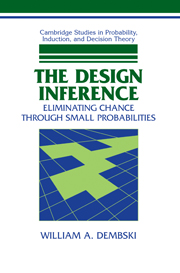Summary
I want in these closing pages to tie together some loose ends. Let's begin with a criticism of the design inference. The question can be raised whether the design inference isn't merely a technique for detecting coincidences, and if so, whether design isn't in the end a trivial mode of explanation. What underlies this criticism is the identification of coincidence with brute concurrence of events for which explanation is not only superfluous, but downright unwelcome. Galen Pletcher (1990, pp. 205–6) describes this sense of coincidence as follows:
To call something a “coincidence” explains nothing. It does exactly the opposite: it asserts that the fact that two events are closely related – in time, and in other ways – does not need to be explained. It says more than that the relation between them cannot (at present) be explained…. To call something a coincidence is to express (even if only implicitly or perhaps even unwittingly) the opinion that it is misguided to search for an explanation (in the proper sense) of the coinciding of the phenomena at issue.
This criticism fails to recognize that not all coincidences are best left unexplained. Yes, the fact that the Shoemaker-Levy comet crashed into Jupiter exactly 25 years to the day after the Apollo 11 moon landing is a coincidence probably best left unexplained. But the fact that Mary Baker Eddy's writings on Christian Science bear a remarkable resemblance to Phineas Parkhurst Quimby's writings on mental healing is a coincidence that deserves to be explained, and is best explained by positing Quimby as a source for Eddy (cf. Martin, 1985, pp. 127–30).
- Type
- Chapter
- Information
- The Design InferenceEliminating Chance through Small Probabilities, pp. 224 - 230Publisher: Cambridge University PressPrint publication year: 1998



